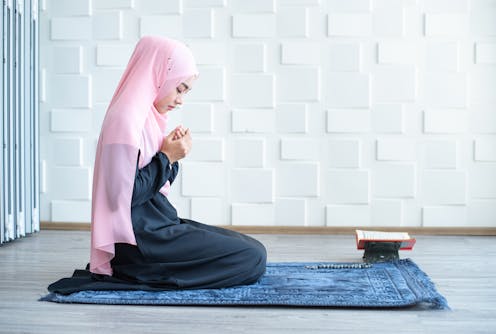2/3 of US colleges and universities lack student groups for Muslims, Jews, Hindus or Buddhists
Buddhist, Hindu, Jewish and Muslim student organizations are rarities at most colleges and universities. An expert delves into why.

The Research Brief is a short take about interesting academic work.
The big idea
Most U.S. colleges and universities lack minority religious student groups for Buddhist, Hindu, Jewish and Muslim students. This is according to our new peer-reviewed study about officially recognized minority religious student groups across 1,953 four-year not-for-profit colleges and universities in the United States.
Colleges and universities across the U.S. typically maintain databases of all student organizations on their campuses. By analyzing those databases, we found that Muslim student groups are located at only 28% of U.S. colleges and universities, while Jewish student groups are at just 25% of U.S. colleges and universities.
Additionally, Buddhist and Hindu student groups are each represented at 5% of colleges and universities. And 66% of U.S. colleges and universities lack any type of minority religious student group.
Using U.S. Department of Education data, we also identified characteristics of schools that are home to one or more minority religious student groups. We found that the presence of minority religious student groups is partly due to institutional resources. For example, schools with large endowments tend to have more minority religious student groups than schools with smaller endowments, partly because wealthier schools employ more student affairs professionals. Those professionals’ jobs are to support student organizations on campus. Also, wealthier schools often provide funds to student organizations.
Beyond providing staff and money, schools with larger numbers of students have more minority religious student groups. This is likely because schools with larger student bodies have more students interested in forming Buddhist, Hindu, Jewish and Muslim student groups.
Finally, certain types of institutions are more likely to have minority religious student groups. We found that approximately 40% of public colleges and universities have minority religious student groups, while only 27% of private Christian colleges and universities have minority religious student groups. This is partly because private Christian colleges or universities are legally allowed to discriminate against non-Christian students, including by refusing to recognize non-Christian student groups. Buddhist, Hindu, Jewish and Muslim students may also avoid attending Christian colleges and universities in the first place.
Why it matters
Research shows that minority religious student groups can provide Buddhist, Hindu, Jewish and Muslim student groups “safe spaces,” even in places where they do not feel welcome. For example, after 9/11, Muslim students faced abuse and harassment on some college and university campuses. Muslim student groups supported these students by providing them with advice on how to navigate unwelcoming campus environments.
Minority religious student organizations also play important roles in transforming their campuses’ policies in ways that make those campuses friendlier to students from minority faiths. For example, national-level organizations such as the Muslim Students Association and Hillel International instruct leaders of local college chapters on how to establish prayer rooms on their campuses. They also provide guidance on how to persuade schools to serve halal or kosher meals, foods that conform to Muslim or Jewish dietary regulations, respectively.
The fact that most colleges and universities lack minority religious student groups means that many students lack resources that could make them feel more welcome on their campuses.
What still isn’t known
When researchers interview leaders or members of student groups, they often identify practical strategies and tactics that students use to form and grow organizations on campus. However, because of our reliance on quantitative data, we don’t know how the strategic thinking and leadership capabilities of Buddhist, Hindu, Jewish and Muslim students may have contributed to the establishment of groups on their campuses.
What’s next
Future research could take a look at the characteristics of schools that have the largest or most active minority religious student organizations. Subsequent research could also identify characteristics of the most effective minority religious student groups.
Jonathan S. Coley is a Public Fellow at the Public Religion Research Institute. He receives funding from the Association for the Sociology of Religion, Association for Research on Nonprofit Organizations and Voluntary Associations, and the Louisville Institute.
Gary John Adler Jr receives funding from the Society for the Scientific Study of Religion, the Religious Research Association, the Association for the Sociology of Religion, the Association for Research on Nonprofit Organizations and Voluntary Associations, the Louisville Institute, and the Institute for Advanced Catholic Studies at the University of Southern California.
Dhruba Das does not work for, consult, own shares in or receive funding from any company or organization that would benefit from this article, and has disclosed no relevant affiliations beyond their academic appointment.
Read These Next
Venezuela’s civil-military alliance is being stretched — if it breaks, numerous armed groups may be
How various factions respond to the Trump administration’s threat to be the de facto ruler of the…
RFK Jr. guts the US childhood vaccine schedule despite its decades-long safety record
In an unprecedented move, health officials cut the number of vaccines routinely recommended for children…
Americans generally like wolves − except when we’re reminded of our politics
New research shows how identity-driven assumptions can turn common ground into conflict.






